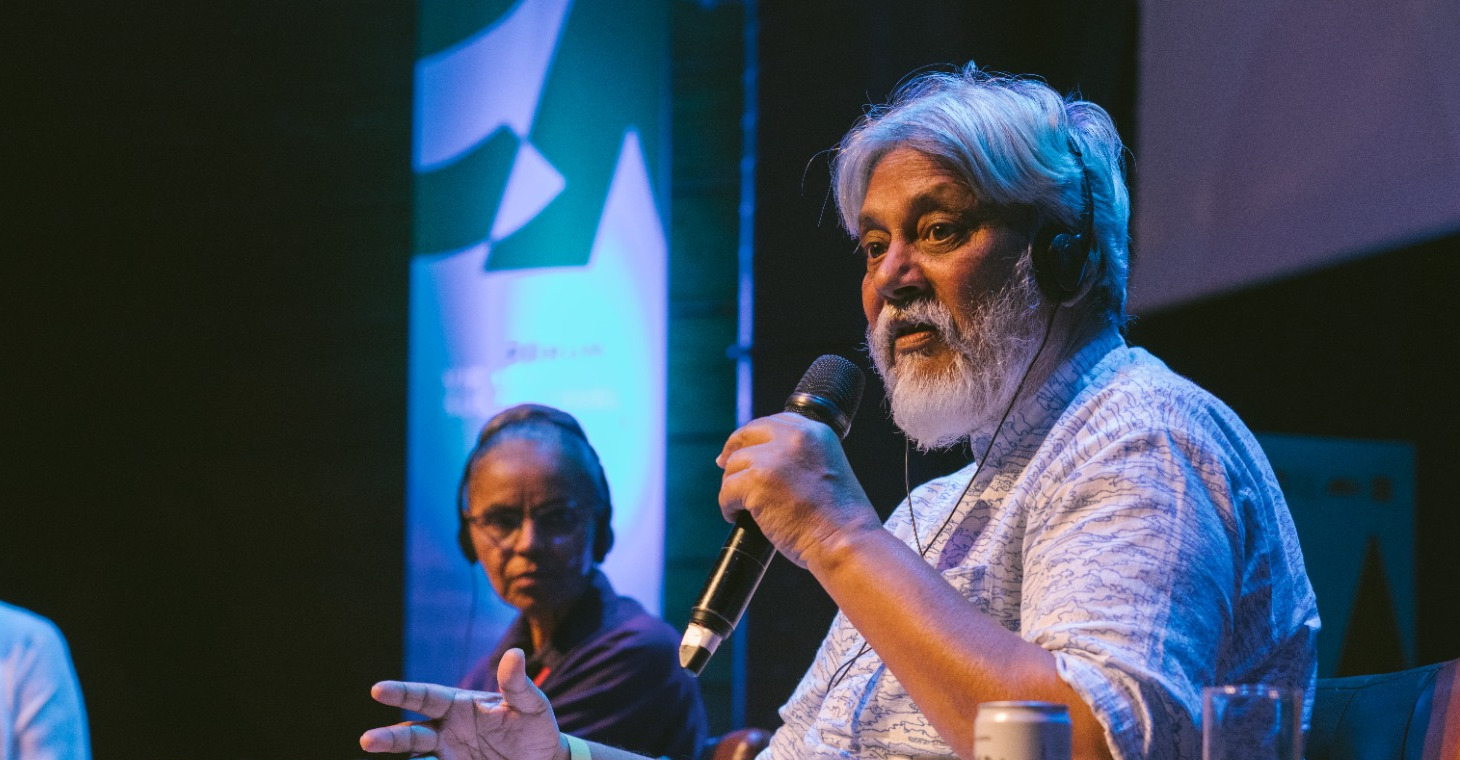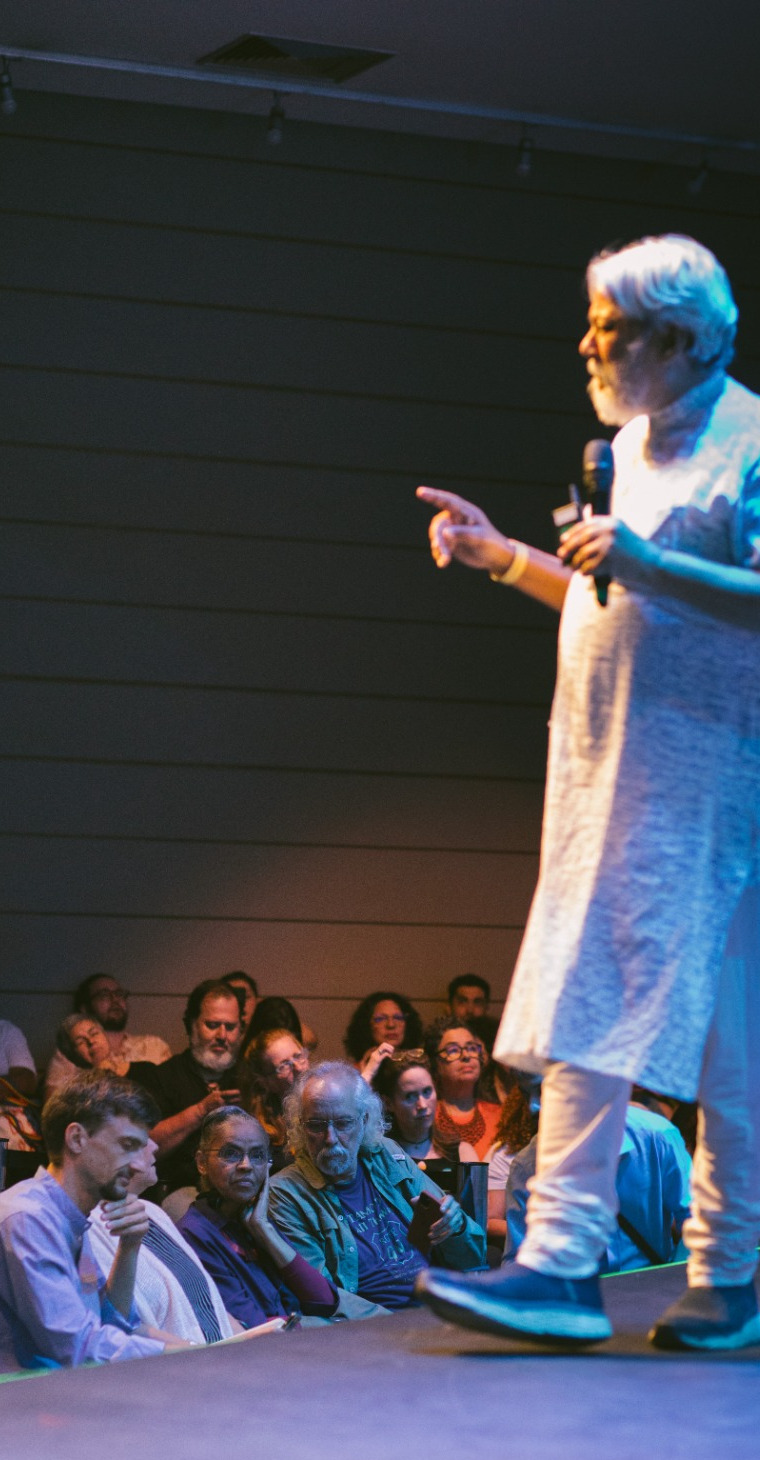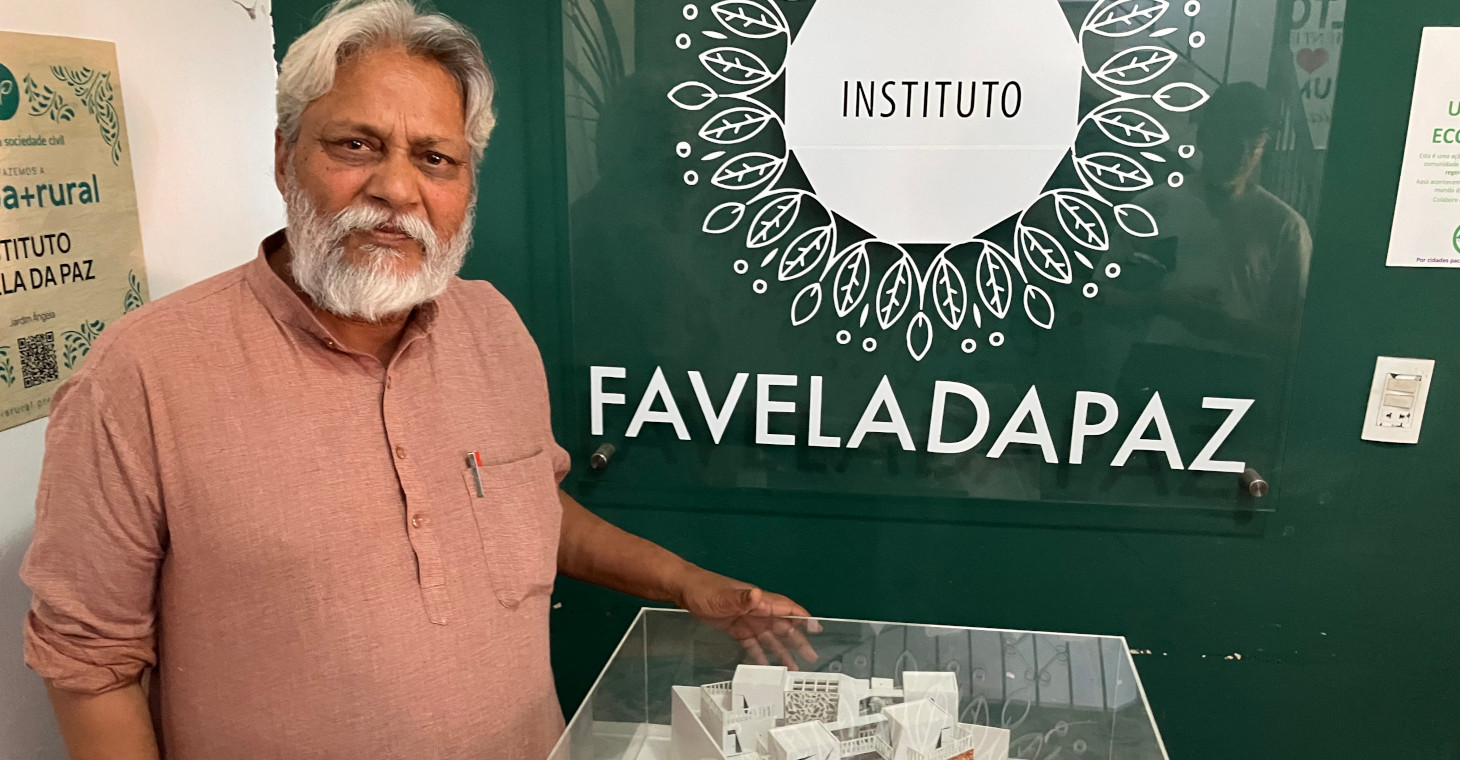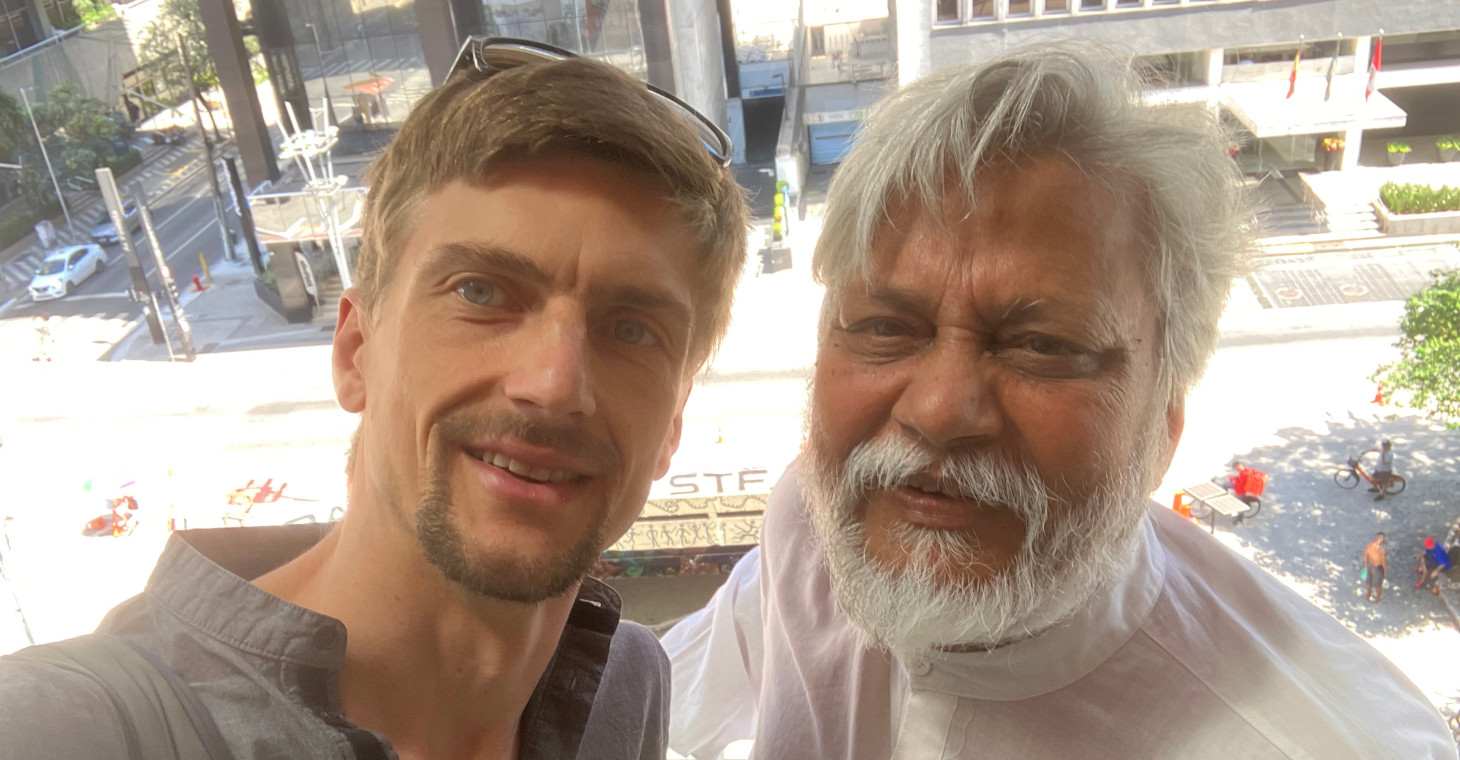“A world free of drought and flood?”
India’s “Waterman” Rajendra Singh visits Brazil to catalyze ecological regeneration
Martin Winiecki, September 28th 2023
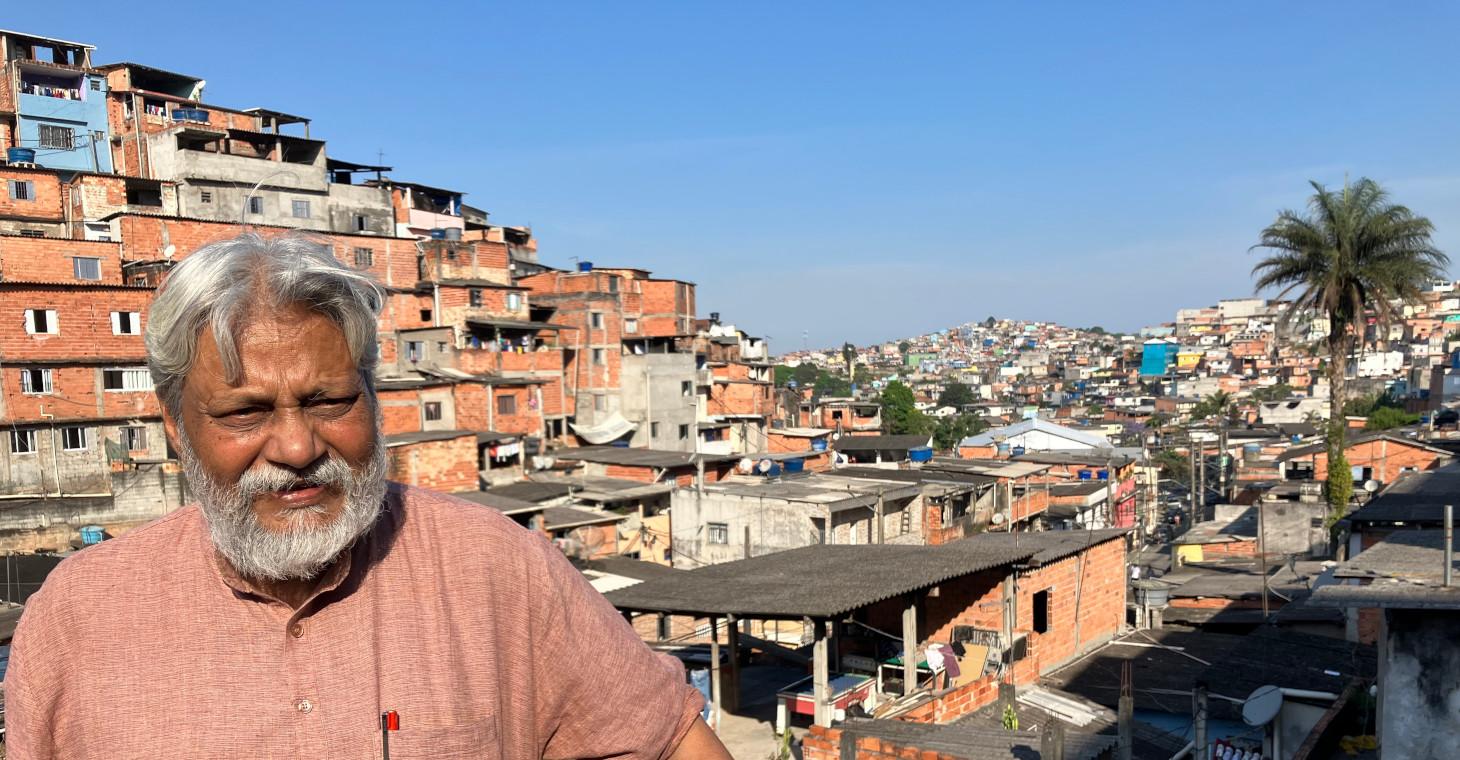
Since the 1980s, a massive and still little known-about ecological grassroots movement has been underway in India. In Rajasthan, the country’s driest state, local communities have regenerated 10,600 square km of desert and semi-desert. The key to these unlikely events has been what Rajendra Singh, the visionary initiator of this movement, describes as “community-driven decentralized water management.”
Dr. Rajendra Singh, also commonly known as “Water Gandhi” or the “Waterman of India,” was in São Paulo this week to share about his work and to support efforts of ecological regeneration in Brazil.
In his mid-20s, Singh was working as an ayurvedic doctor in rural Rajasthan when village elders challenged him to put his medical work aside and instead deal with the extreme water stress the region was experiencing. One of these elders taught him about traditional Indigenous water conservation methods, which Singh soon put into practice. With his own hands, he built a so called “johad,” a small unsealed pond-like structure which retains the precious winterrain and allows it to filter into the aquifer. While people first laughed at him, to the surprise of many, groundwater levels in the local wells rose several meters soon after the next rains. As word spread and more and more people got involved, Singh started the NGO Tarun Bharat Sangh to upscale his work. By mobilizing local communities, his quickly growing team built hundreds and finally thousands of these decentralized small and medium-scale structures and created a diverse vegetation cover. The movement achieved the seemingly impossible: by recharging aquifers and building vegetation, springs, creeks and rivers started flowing again — and with the water, life returned to the region. 14 rivers that had dried up now carry water all year round, even during dry spells. Today, hundreds of thousands of people live self-sufficiently off these lands. Their work has been honored with numerous rewards, among them the Stockholm Water Prize, and The Guardian named Singh one of “50 people who could save the planet.”
Taking his experience to the global stage, Singh last year started the “People’s World Commission on Drought & Flood.” He’s now traveling the world to find like-minded people and kick off an international movement.
During his stay last week, southeast Brazil saw temperatures as high as they haven’t been in 80 years while big floods further down in Rio Grande do Sul forced people to evacuate houses and caused severe damages.
Singh sees these extreme weather events not only as symptoms of the greenhouse effect but also of broken water cycles. For him “water is climate and climate is water.” Singh explains that plants and forests are essential for animating water cycles on land. As sunlight meets healthy vegetation, plants evapotranspire water and release it as vapor, which — in addition to cooling the atmosphere — functions as a biotic pump that lures clouds from the sea onto the land. In simpler words, healthy vegetation makes rain.
Yet, when vegetation and soils are degraded through deforestation, monoculture, drainage and urbanization, this natural function is no longer there. When sunlight hits bare ground, it has the opposite effect: it releases sensible heat. When this happens in large areas, the rising heat usually blocks clouds that gather over the sea from coming inland. Often, a lot of water vapor must accumulate over the sea before it can move onto the land, adding to the growing number and intensity of torrential rainfalls. Without vegetation and with eroded soils, the rainwater that can no longer filter into the ground runs off, causing floods during heavy precipitation and drought during dry spells.
Drought and flood are already affecting 40% of the world’s land area and billions of people. Singh warns that if we continue on our current trajectory of ecological degradation, we’re headed for much worse: devastating water wars with hundreds of millions of climate refugees.
Yet, as he has shown, this scenario is far from inevitable. Tarun Bharat Sangh has demonstrated that drought and flood aren’t primarily a matter of how much rain falls, but of whether or not the rain that does fall can sink into the ground. Thanks to decentralized rainwater retention, people and nature in Rajasthan now enjoy regenerative water autonomy — even in areas with as little as 250 mm of annual rainfall. Because these measures have been applied to large contiguous areas, the regional climate started to change for the better: Rainfall increased and became more balanced again, and average temperatures fell by 2-3 degree Celsius.
And the ecological restoration ushered in far-reaching social transformations as well. In some communities with previously a lot of violence, crime and urban flight, local communities now live together peacefully because there’s security for their livelihoods and because local communities have organized in “river parliaments” to preserve water as a common good for the benefit of all.
Confronting the extreme weather events and climatic disruptions around the world, Singh hopes to apply the lessons he learnt in India to raise a global movement for ecosystem and climate restoration.
The goal of the commission he is starting is undoubtedly ambitious: To implement community-driven decentralized water management on medium and large scales in 100 bioregions around the world in the next 10 years. To get there, various levels of work will have to be addressed in parallel: ecological intervention in relevant model sites, training for water engineers and landscape designers, raising awareness about the importance of water for the climate, connecting those already engaged in this work and lobbying for policy change. The commission’s structure is decentralized: Instead of a global office advising what should happen in each part of the world, people self-organize in regional and national chapters according to the needs of their particular contexts. Some of these chapters have already begun working, such as in India, Egypt, Kenya, and in Portugal.
Singh met with civil society organizations, political leaders, social movements, entrepreneurs and activists in São Paulo to start a Brazilian chapter of the commission.
After inviting me to chair the commission in Portugal and Spain last year, I had the honor to accompany him on his journey to Brazil. In my community at Tamera, an international peace research center in the Alentejo region in Portugal, we’ve worked on water conservation for the last 15 years and are now preparing to upscale this approach in our region to counteract severe and extreme drought.
At Fórum Virada Sustentável, Brazil’s biggest sustainability festival, Singh shared a panel with Brazil’s environment minister and veteran forest defender Marina Silva, who expressed her admiration for his work. She spoke of feeling a “deep connection” when she heard Singh speak; adding that “although we haven’t met before, I feel like we’ve known each other for a long time.”
Silva recognizes the importance of healthy ecosystems for maintaining water cycles and climatic stability. Speaking to Singh, she said, “You’re in love with the water, just as I’m in love with the forests. I believe that forest and water are inseparable.” Referring to the “flying rivers” over the Amazon, she added, “Without forest, there’s no water; without water, there’s no forest.”
Being someone who’s been strongly engaged in forest protection since her youth, Silva is giving her all to prevent what she calls the “point of no return” in the Amazon. Her ministry is leading the new government’s uphill battle to achieve “zero deforestation” by 2030 and to champion sustainable development.
Scientists warn that unless deforestation is stopped in the next few years, the conversion of the Amazon rainforest and other biomes into dry savannah will soon be irreversible. The collapse of the Amazon, they estimate, would disrupt water cycles from Patagonia to Canada and supercharge global heating.
So far, the early results of Silva’s work have positively shocked scientists and activists alike; deforestation figures plummeted just a few months into her term. But the mission to preserve the Amazon remains extremely challenging, given that a whole coalition of powerful economic interests — especially timber, mining, and agricultural industries together with arms suppliers and missionaries — are invested in accelerating deforestation.
Brazil’s Indigenous people who have entangled with local ecosystems for centuries and millennia, are the first and foremost guardians of Brazil’s forests but also the ones who have most suffered from the encroachment of extractive industries. They make up an enormous cultural diversity, with more than 300 nations and 274 spoken languages still today. Although the colonial violence remains ruthless, Brazil’s Indigenous people, especially women, are leading a true cultural and spiritual transformation of Brazilian politics — within Lula’s government and society at large.
While we were there, we witnessed a historic victory for Indigenous sovereignty: Brazil’s supreme court declared a law proposal as unconstitutional, which the right-wing majority in Congress had approved. “Marco Temporal,” if passed, would strip many Indigenous communities of their lands and open it up to mining, deforestation and large infrastructure projects.
The power of this burgeoning Indigenous rights movement is much more than just strategic intelligence. It’s rooted in other ways of being, knowing and relating. Indigenous congresswoman Célia Xakriabá speaks of “reforesting politics,” a project of far-reaching societal transformation based on reclaiming Indigenous identity and practices of honoring our interdependence with all living beings.
The dialogue between Marina Silva and Rajendra Singh mirrored this sense of reverence for Earth. In different words they both hinted at the spirituality driving their enormous ecological engagement, that it’s been love and the will to live has allowed them to make the seemingly impossible possible time and again. They equally share an understanding that any ecological changes, in order to be sustainable, need to be anchored in culture.
In addition to the Indigenous water and forest protectors, this shift of culture in Brazil is championed by powerful bottom-up initiatives. During our stay, we visited and created ties with some of these. Institute for Water and Sanitation is campaigning for clean drinking water and sanitation to be guaranteed as human rights. In Itu, a municipality an hour outside São Paulo that had struggled with water stress, SOS Mata Atlântica showed in just 15 years how a medium-sized desiccated area can hold and retain water by regrowing the native Atlantic rainforest. The landless and homeless workers movements have shown how people disenfranchised by state and capitalism can uphold their rights to livelihood and dignity through organizing themselves in decentralized, regenerative communities.
From the convergence of these and other initiatives, a group of interested activists will meet over the coming months to organize the People’s World Commission on Drought and Flood in Brazil. Alan Dubner (Fundação Rede Brasil Sustentável) and Claudio Miranda (Instituto Favela da Paz) are coordinating this still-lose network as it constitutes itself and develops an action plan.
Although this transformation will continue to prove complex and challenging in Brazil, the country is undoubtedly a powerhouse of social and ecological change. Adopting community-driven, decentralized water management through south-south cooperation and local organizing might help the country not only to prevent ecosystem breakdown but to lead the inevitable transformation towards an ecological civilization.

